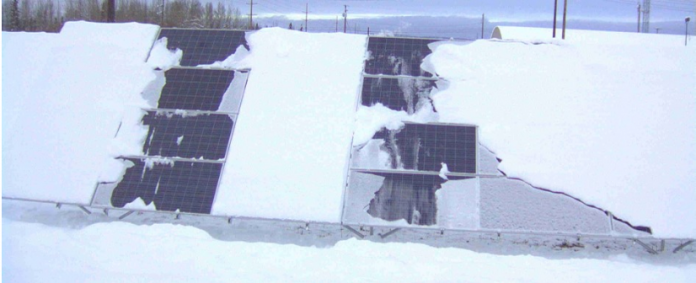U.S. researchers have developed a coating system that is claimed to effectively enable the repeated, passive shedding of snow and ice in utility scale solar plants over a wide range of sub-zero temperatures down to -35 degrees Celsius.
“With some additional testing, our technology would be immediately applicable to real solar installations,” the research corresponding author, Anish Tuteja, told pv magazine. “We plan on doing more extended experiments soon, where the coating will be tested for a couple of years on outdoor solar panels.”
The 50μm coating consists of an optically transparent surface that exhibits both extremely low ice interfacial adhesion and toughness. It was fabricated by using a solution of medium-chain triglyceride (MCT) oil with a weight content of 60wt% to plasticize two common industrial polymer polyvinyl chlorides known as MC2 and MC6, respectively.
The two solutions were tested in a subset of 72-cell panels measuring 2x1m on a grid-tied PV system operated by an Alaskan utility in Fairbanks during the winters of 2019 and 2020. The tilt angle of the installation was set at 45 degrees to facilitate snow dropping, and all 16 modules used for the experiment were equipped with micro-inverters. Both the MC2 and MC6 solutions were applied to the module surface glass and structural frame.
The panels were installed four-up in landscape orientation and each column including coated panels was separated by a column hosting uncoated panels. “Data on snow shedding were collected by a research-grade camera positioned normal[ly] to each array and with a field-of-view sufficient to capture the full array of experimental panels,” the scientists explained. “In a matter of minutes, both the MC2 and MC6 columns showed accelerated snow shedding, relative to the uncoated control column, with snow coverage reduced by around 61% and approximately 32% on MC2 and MC6 [-coated panels], respectively.”
The uncoated panels, by contrast, remained completely covered by snow and ice during the testing period and were able to produce almost zero electricity. Snow removal caused by wind was minimal during testing, as winds with very limited speed were registered.
The scientists found that the MC2 solution achieves the best performance, resulting in an average snow coverage area of only 27.7%, while the MC6 solution was able to achieve an average of 45.4%. The latter was found to have lower mechanical strength, which also brought delamination to the panels. The former maintained its performance and stability over the 77 days of the experiment.
The scientists emphasized that the coating technology is able to shed different types of snow and ice and said it may also be applied to building-integrated PV. “The material costs are expected to be fairly low,” Tuteja told pv magazine. “I would estimate them to be less than $1 per square footage.”
The novel technique is proposed in the paper Facilitating Large-Scale Snow Shedding from In-Field Solar Arrays using Icephobic Surfaces with Low-Interfacial Toughness, published in Advanced Materials Technologies. The research group comprises scientists from the University of Michigan, the University of Alaska, and the U.S. Department of Energy’s Sandia National Laboratories.






